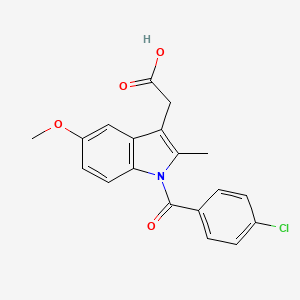indomethacin, 53-86-1, indometacin, Indocin, Indomethacine, Indometacine, Indocid, Reumacide, Indomethazine, Metindol, Artrinovo, Confortid, Idomethine, Indomecol, Indomethacinum, Metartril, Methazine, Artrivia, Dolovin, Imbrilon, Indacin, Indomed, Indomee, Indoptol, Infrocin, Metacen, Sadoreum, Amuno, Inacid, Tannex, Indo-rectolmin, Inteban sp, Artracin, Durametacin, Indoptic, Inflazon, Mikametan, Lausit, Mezolin, Mobilan, Indo-tablinen, Indo-Lemmon, Indometacinum, Indometacyna, Indometicina, Indocin Sr, Indometacina, Aconip, 2-(1-(4-Chlorobenzoyl)-5-methoxy-2-methyl-1H-indol-3-yl)acetic acid, Indmethacine, Dolcidium, Elmetacin, Indomethine, Indorektal, Tivorbex, Catlep, Indoxen, Vonum, 1H-Indole-3-acetic acid, 1-(4-chlorobenzoyl)-5-methoxy-2-methyl-, Indo-phlogont, Chibro-amuno, Bonidon Gel, Dolcidium PL, Rheumacin LA, Osmosin, 1-(p-Chlorobenzoyl)-5-methoxy-2-methylindole-3-acetic acid, CCRIS 3502, HSDB 3101, Indometacine [INN-French], Indometacinum [INN-Latin], Indometacina [INN-Spanish], FLAM, Inteban, 1-(4-Chlorobenzoyl)-5-methoxy-2-methyl-3-indoleacetic acid, NCI-C56144, UNII-XXE1CET956, 1-(4-Chlorobenzoyl)-5-methoxy-2-methyl-1H-indole-3-acetic acid, 2-[1-(4-chlorobenzoyl)-5-methoxy-2-methylindol-3-yl]acetic acid, EINECS 200-186-5, XXE1CET956, MFCD00057095, Indometacin [INN], NSC-757061, 1-(p-Chlorobenzoyl)-2-methyl-5-methoxyindole-3-acetic acid, BRN 0497341, USAN, Indomethacin (Indocid, Indocin), CHEBI:49662, CHEMBL6, NSC-77541, IMN, Indole-3-acetic acid, 1-(p-chlorobenzoyl)-5-methoxy-2-methyl-, Indomethacin [USAN:USP], alpha-(1-(p-Chlorobenzoyl)-2-methyl-5-methoxy-3-indolyl)acetic acid, 2-{1-[(4-chlorophenyl)carbonyl]-5-methoxy-2-methyl-1h-indol-3-yl}acetic acid, N-p-Chlorbenzoyl-5-methoxy-2-methylindole-3-acetic acid, MLS000069402, DTXSID9020740, (1-p-Chlorobenzoyl-5-methoxy-2-methylindol-3-yl)acetic acid, 1-(p-chlorobenzoyl)-5-methoxy-2-methyl-3-indolylacetic acid, 1-(p-Chlorobenzoyl)-2-methoxy-3-methyl-1H-indole-3-acetic Acid, Indomet 140, EC 200-186-5, [1-(4-Chlorobenzoyl)-5-methoxy-2-methyl-1H-indol-3-yl]acetic acid, 5-22-05-00239 (Beilstein Handbook Reference), {1-[(4-chlorophenyl)carbonyl]-5-methoxy-2-methyl-1H-indol-3-yl}acetic acid, NSC 757061, CAS-53-86-1, 1-p-Cloro-benzoil-5-metoxi-2-metilindol-3-acido acetico, NCGC00015562-18, Indomethancin, 1-(4-chlorobenzoyl)-5-methoxy-2-methylindole-3-acetic acid, Arthrexin, Bonidin, Bonidon, Indameth, Indomod, Miametan, SMR000058195, Indomo, Flexin continus, Hicin, Kwas 1-(p-chlorobenzoilo)-2-metylo-5-metoksy-3-indolilooctowy, Chrono-indicid, Chrono-indocid, Indometacyna [Polish], Indometicina [Spanish], 2-[1-(4-chlorobenzoyl)-5-methoxy-2-methyl-1H-indol-3-yl]acetic acid, Indo-Spray, Indomethacin (USAN:USP), Indolar SR, Indometacine (INN-French), Indometacinum (INN-Latin), Indometacina (INN-Spanish), INDOMETACIN (MART.), INDOMETACIN [MART.], DTXCID50740, INDOMETHACIN (USP-RS), INDOMETHACIN [USP-RS], 1-(p-chlorobenzoyl)-2-methyl-5-methoxy-3-indoleacetic acid, INDOMETACIN (EP MONOGRAPH), INDOMETACIN [EP MONOGRAPH], INDOMETHACIN (USP MONOGRAPH), INDOMETHACIN [USP MONOGRAPH], 2-[1-(4-chlorobenzoyl)-5-methoxy-2-methyl-indol-3-yl]acetic acid, (1-(4-CHLOROBENZOYL)-5-METHOXY-2-METHYL-1H-INDOL-3-YL)ACETIC ACID, 2-{1-[(4-chlorophenyl)carbonyl]-5-methoxy-2-methylindol-3-yl}acetic acid, Indocin-SR, Indochron E-R, Indocin (TN), ACEMETACIN IMPURITY B (EP IMPURITY), ACEMETACIN IMPURITY B [EP IMPURITY], Aconip (TN), Indomethacin (USP), NSC77541, Indocid (pharmaceutical), SR-01000000014, Indomethacin & MAP-30, Indocollyre, Indonol, Innamit, 1-(p-Chlorobenzoyl)-5-methoxy-2-methyl-Indole-3-acetic acid, IndomethacinER, Indomethacin ER, 2-{1-((4-chlorophenyl)carbonyl)-5-methoxy-2-methylindol-3-yl}acetic acid, 4kyk, (1-((4-chlorophenyl)carbonyl)-5-methoxy-2-methyl-1H-indol-3-yl)acetic acid, Indomethacin,(S), Prestwick_597, INDREN, Indometacinum (Latin), Opera_ID_56, Spectrum_000919, Tocris-1708, 1z9h, 1-(p-Chlorbenzoyl)-5-methoxy-2-methylindol-3-essigsaeure [German], 1-p-Cloro-benzoil-5-metoxi-2-metilindol-3-acido acetico [Spanish], Prestwick0_000272, Prestwick1_000272, Prestwick2_000272, Prestwick3_000272, Spectrum2_000970, Spectrum3_000468, Spectrum4_000018, Spectrum5_000868, INDOMETACIN [JAN], INDOMETHACIN [MI], Lopac-I-7378, Kwas 1-(p-chlorobenzoilo)-2-metylo-5-metoksy-3-indolilooctowy [Polish], CHRONO-INDOCID 75, MolMap_000032, UPCMLD-DP023, I 7378, Indometacin (JP17/INN), INDOMETHACIN [HSDB], INDOMETHACIN [USAN], SCHEMBL9300, INDOMETHACIN [VANDF], Indomethacin Extended-release, Lopac0_000692, Oprea1_686105, BSPBio_000144, BSPBio_001149, BSPBio_002176, INDOMETACIN [WHO-DD], INDOMETACIN [WHO-IP], Indomethacine impurity mixture, KBioGR_000395, KBioGR_000489, KBioSS_000489, KBioSS_001399, MLS001074194, MLS006011845, BIDD:GT0132, DivK1c_000271, SPECTRUM1500350, SPBio_000979, SPBio_002363, BPBio1_000160, GTPL1909, Indomethacin, >=99% (TLC), UPCMLD-DP023:001, BDBM17638, CGIGDMFJXJATDK-UHFFFAOYSA-, HMS500N13, KBio1_000271, KBio2_000489, KBio2_001399, KBio2_003057, KBio2_003967, KBio2_005625, KBio2_006535, KBio3_000897, KBio3_000898, KBio3_001396, 1-(p-Chlorbenzoyl)-5-methoxy-2-methylindol-3-essigsaeure, C01EB03, M01AB01, M02AA23, S01BC01, Indomethacin - CAS 53-86-1, NINDS_000271, Bio2_000405, Bio2_000885, HMS1362I11, HMS1568H06, HMS1792I11, HMS1920F21, HMS1990I11, HMS2089N19, HMS2091N09, HMS2095H06, HMS2231J10, HMS3262K05, HMS3268A14, HMS3374F07, HMS3403I11, HMS3414N13, HMS3430L03, HMS3649K17, HMS3655O04, HMS3678N11, HMS3712H06, HMS3747K21, HMS3884E08, INDOMETHACIN [ORANGE BOOK], Indomethacin-d4(chlorobenzoyl-d4), Pharmakon1600-01500350, BCP18951, Indomethacin, >=99.0% (TLC), Tox21_113109, Tox21_201791, Tox21_300266, Tox21_500692, AC-532, CCG-40186, HB4422, INDOMETACINUM [WHO-IP LATIN], NSC757061, s1723, STL257874, AKOS000592893, Tox21_113109_1, AT13679, DB00328, Indometacin 1.0 mg/ml in Acetonitrile, KS-5255, LP00692, SDCCGSBI-0050670.P005, IDI1_000271, IDI1_002160, NCGC00015562-01, NCGC00015562-02, NCGC00015562-03, NCGC00015562-04, NCGC00015562-05, NCGC00015562-06, NCGC00015562-07, NCGC00015562-08, NCGC00015562-09, NCGC00015562-10, NCGC00015562-11, NCGC00015562-12, NCGC00015562-13, NCGC00015562-14, NCGC00015562-15, NCGC00015562-16, NCGC00015562-17, NCGC00015562-19, NCGC00015562-20, NCGC00015562-21, NCGC00015562-22, NCGC00015562-24, NCGC00015562-25, NCGC00015562-40, NCGC00024135-02, NCGC00024135-04, NCGC00024135-05, NCGC00024135-06, NCGC00024135-07, NCGC00024135-08, NCGC00024135-09, NCGC00024135-10, NCGC00024135-11, NCGC00024135-12, NCGC00024135-13, NCGC00024135-14, NCGC00024135-15, NCGC00254075-01, NCGC00259340-01, NCGC00261377-01, BI166166, BP-30207, HY-14397, NCI60_041708, O-Desmethyl-des-4-chlorobenzoylacemetacin, SBI-0050670.P004, DB-052413, AB00052022, EU-0100692, FT-0603227, I0655, NS00000217, SW196768-5, EN300-16807, Indomethacin, meets USP testing specifications, BIM-0050670.0001, C01926, D00141, S00108, AB00052022-20, AB00052022-21, AB00052022_23, AB00052022_24, L000959, Q409231, Indomethacin, Antibiotic for Culture Media Use Only, Q-201239, SR-01000000014-2, SR-01000000014-4, SR-01000000014-6, 1-(4-Chlorobenzoyl)-5-methoxy-2-met hyl-1H-indole, BRD-K57222227-001-06-1, BRD-K57222227-001-18-6, BRD-K57222227-001-27-7, SR-01000000014-10, SR-01000000014-16, Z56784896, 1-p-chlorobenzoyl-2-methyl-5-methoxyindol-3-acetic acid, 1-(p-chlorobenzoyl)-5-methoxy-2-methyl-3-indoleacetic acid, 1-(p-Chlorobenzoyl)-5-methoxy-2-methylindol-3-acetic acid, 1-(p-chlorobenzyl)-5-methoxy-2-methylindole-3-acetic acid, 1-(4-chloro-benzoyl)-5-methoxy-2-methyl-3-indolyl-acetic acid, 1-(4-Chlorobenzoyl)-2-methyl-5-methoxyindole-3-acetic acid, 1-(p-Chlorobenzoyl)-2-methyl-5-methoxy-3-indole-acetic acid, 1-(p-chlorobenzoyl)-2-methyl-5-methoxy-3-indolylacetic acid, 1-(p-chlorobenzoyl)-5-methoxy-2-methyl-3-indol acetic acid, Indomethacin, European Pharmacopoeia (EP) Reference Standard, N-(p-Chlorobenzoyl)-2-methyl-5-methoxy-3-indolylacetic acid, 1-(4-chlorobenzoyl)-5-methoxy-2-methyl-1-H-indole-3-acetic acid, Indomethacin, United States Pharmacopeia (USP) Reference Standard, N-P-CHLOROBENZOYL-5-METHOXY-2-METHYLINDOLE-3-ACETIC ACID, .alpha.-(1-(p-Chlorobenzoyl)-2-methyl-5-methoxy-3-indolyl)acetic acid, [1-(4-Chlorobenzoyl)-5-methoxy-2-methyl-1H-indol-3-yl]acetic acid #, 1-(4-Chlorobenzoyl)-5-methoxy-2-methyl-1H-indole-3-acetic acid & MAP-30, 1H-Indole-3-acetic acid, 1-(4-chlorobenzoyl)-5-methoxy-2-methyl- (9CI), 2-{1-[(4-chlorophenyl)carbonyl]-5-methoxy-2 methylindol-3-yl}acetic acid, 2-{1-[(4-chlorophenyl)carbonyl]-5-methoxy-2methylindol-3-yl}acetic acid, Indole-3-acetic acid, 1-(p-chlorobenzoyl)-5-methoxy-2-methyl- (8CI), Indomethacin, Pharmaceutical Secondary Standard; Certified Reference Material, InChI=1/C19H16ClNO4/c1-11-15(10-18(22)23)16-9-14(25-2)7-8-17(16)21(11)19(24)12-3-5-13(20)6-4-12/h3-9H,10H2,1-2H3,(H,22,23)



